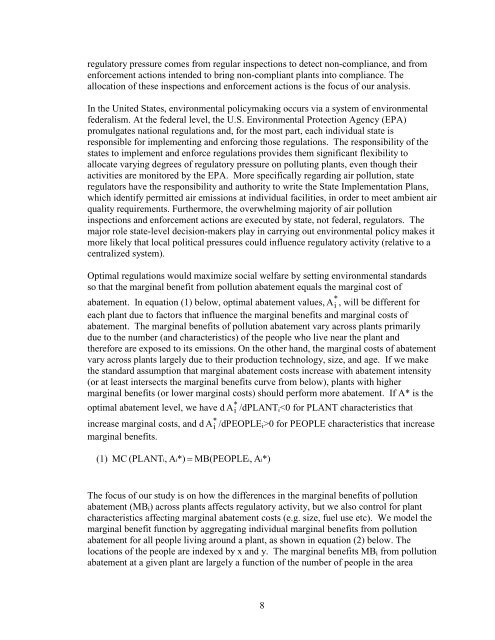Environmental Racism
Environmental Racism
Environmental Racism
You also want an ePaper? Increase the reach of your titles
YUMPU automatically turns print PDFs into web optimized ePapers that Google loves.
egulatory pressure comes from regular inspections to detect non-compliance, and from<br />
enforcement actions intended to bring non-compliant plants into compliance. The<br />
allocation of these inspections and enforcement actions is the focus of our analysis.<br />
In the United States, environmental policymaking occurs via a system of environmental<br />
federalism. At the federal level, the U.S. <strong>Environmental</strong> Protection Agency (EPA)<br />
promulgates national regulations and, for the most part, each individual state is<br />
responsible for implementing and enforcing those regulations. The responsibility of the<br />
states to implement and enforce regulations provides them significant flexibility to<br />
allocate varying degrees of regulatory pressure on polluting plants, even though their<br />
activities are monitored by the EPA. More specifically regarding air pollution, state<br />
regulators have the responsibility and authority to write the State Implementation Plans,<br />
which identify permitted air emissions at individual facilities, in order to meet ambient air<br />
quality requirements. Furthermore, the overwhelming majority of air pollution<br />
inspections and enforcement actions are executed by state, not federal, regulators. The<br />
major role state-level decision-makers play in carrying out environmental policy makes it<br />
more likely that local political pressures could influence regulatory activity (relative to a<br />
centralized system).<br />
Optimal regulations would maximize social welfare by setting environmental standards<br />
so that the marginal benefit from pollution abatement equals the marginal cost of<br />
*<br />
abatement. In equation (1) below, optimal abatement values, A i , will be different for<br />
each plant due to factors that influence the marginal benefits and marginal costs of<br />
abatement. The marginal benefits of pollution abatement vary across plants primarily<br />
due to the number (and characteristics) of the people who live near the plant and<br />
therefore are exposed to its emissions. On the other hand, the marginal costs of abatement<br />
vary across plants largely due to their production technology, size, and age. If we make<br />
the standard assumption that marginal abatement costs increase with abatement intensity<br />
(or at least intersects the marginal benefits curve from below), plants with higher<br />
marginal benefits (or lower marginal costs) should perform more abatement. If A* is the<br />
optimal abatement level, we have d A * i /dPLANT i 0 for PEOPLE characteristics that increase<br />
marginal benefits.<br />
(1) MC (PLANT i , A i*)<br />
= MB(PEOPLE i,<br />
A i*)<br />
The focus of our study is on how the differences in the marginal benefits of pollution<br />
abatement (MB i ) across plants affects regulatory activity, but we also control for plant<br />
characteristics affecting marginal abatement costs (e.g. size, fuel use etc). We model the<br />
marginal benefit function by aggregating individual marginal benefits from pollution<br />
abatement for all people living around a plant, as shown in equation (2) below. The<br />
locations of the people are indexed by x and y. The marginal benefits MB i from pollution<br />
abatement at a given plant are largely a function of the number of people in the area<br />
8

















